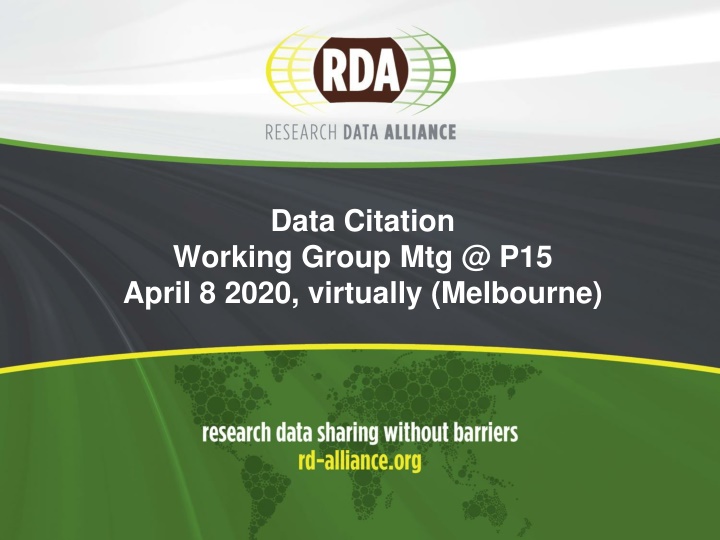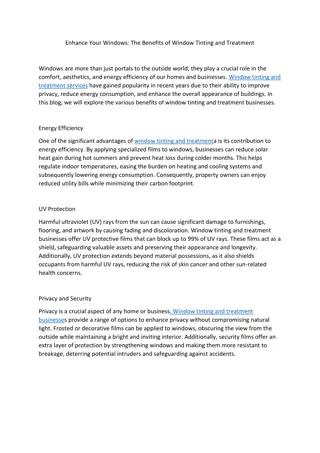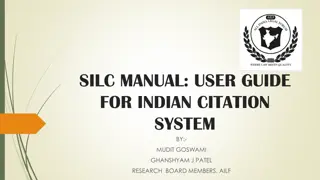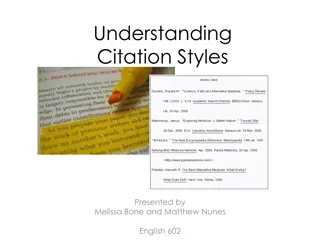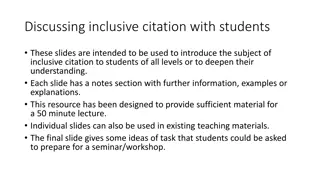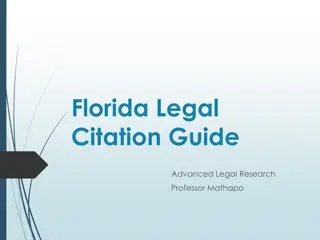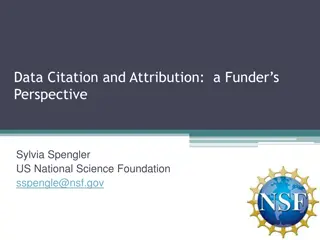Data Citation Working Group Mtg @ P15 April 8 2020, virtually (Melbourne)
Large dynamic datasets often pose challenges in identifying specific subsets of data accurately. The need to precisely pinpoint data at a particular timestamp while maintaining scalability and accuracy is crucial. The Research Data Alliance Working Group on Data Citation addresses these issues and emphasizes the importance of making dynamic data citeable. Learn about current approaches and the evolution of strategies for handling dynamic and changing datasets.
Download Presentation

Please find below an Image/Link to download the presentation.
The content on the website is provided AS IS for your information and personal use only. It may not be sold, licensed, or shared on other websites without obtaining consent from the author.If you encounter any issues during the download, it is possible that the publisher has removed the file from their server.
You are allowed to download the files provided on this website for personal or commercial use, subject to the condition that they are used lawfully. All files are the property of their respective owners.
The content on the website is provided AS IS for your information and personal use only. It may not be sold, licensed, or shared on other websites without obtaining consent from the author.
E N D
Presentation Transcript
Data Citation Working Group Mtg @ P15 April 8 2020, virtually (Melbourne)
Agenda 2 Introduction, Welcome Short description of the WG recommendations Q&A on recommendations Reports by adopters / pilots Paper on adoption stories Other issues, next steps
Welcome and Intro 3 Welcome! to the maintenance meeting of the WGDC
Agenda 4 Introduction, Welcome Short description of the WG recommendations Q&A on recommendations Reports by adopters / pilots Paper on adoption stories Other issues, next steps
Identification of Dynamic Data 5 Usually, datasets have to be static Fixed set of data, no changes: no corrections to errors, no new data being added But: (research) data is dynamic Adding new data, correcting errors, enhancing data quality, Changes sometimes highly dynamic, at irregular intervals Current approaches Identifying entire data stream, without any versioning Using accessed at date Artificial versioning by identifying batches of data (e.g. annual), aggregating changes into releases (time-delayed!) Would like to identify precisely the data as it existed at a specific point in time
Granularity of Subsets 6 What about the granularity of data to be identified? Enormous amounts of CSV data Researchers use specific subsets of data Need to identify precisely the subset used Current approaches Storing a copy of subset as used in study -> scalability Citing entire dataset, providing textual description of subset -> imprecise (ambiguity) Storing list of record identifiers in subset -> scalability, not for arbitrary subsets (e.g. when not entire record selected) Would like to be able to identify precisely the subset of (dynamic) data used in a process
RDA WG Data Citation 7 Research Data Alliance WG on Data Citation: Making Dynamic Data Citeable March 2014 September 2015 Concentrating on the problems of large, dynamic (changing) datasets Final version presented Sep 2015 at P7 in Paris, France Endorsed September 2016 at P8 in Denver, CO Since: support for take-up/adoption, lessons-learned https://www.rd-alliance.org/groups/data-citation-wg.html
Dynamic Data Citation 8 We have: Data + Means-of-access ( query )
Dynamic Data Citation 9 We have: Data + Means-of-access ( query ) Dynamic Data Citation: Cite (dynamic) data dynamically via query!
Dynamic Data Citation 10 We have: Data + Means-of-access ( query ) Dynamic Data Citation: Cite (dynamic) data dynamically via query! Steps: 1. Data versioned (history, with time-stamps)
Dynamic Data Citation 11 We have: Data + Means-of-access ( query ) Dynamic Data Citation: Cite (dynamic) data dynamically via query! Steps: 1. Data versioned (history, with time-stamps) Researcher creates working-set via some interface:
Dynamic Data Citation 12 We have: Data + Means-of-access ( query ) Dynamic Data Citation: Cite (dynamic) data dynamically via query! Steps: 1. Data versioned (history, with time-stamps) Researcher creates working-set via some interface: 2. Access store & assign PID to QUERY , enhanced with Time-stamping for re-execution against versioned DB Re-writing for normalization, unique-sort, mapping to history Hashing result-set: verifying identity/correctness leading to landing page
Data Citation Deployment 13 Researcher uses workbench to identify subset of data Upon executing selection ( download ) user gets Data (package, access API, ) PID (e.g. DOI) (Query is time-stamped and stored) Hash value computed over the data for local storage Recommended citation text (e.g. BibTeX) PID resolves to landing page Provides detailed metadata, link to parent data set, subset, Option to retrieve original data OR current version OR changes Upon activating PID associated with a data citation Query is re-executed against time-stamped and versioned DB Results as above are returned Query store aggregates data usage
Data Citation Deployment 14 Note: query string provides excellent provenance information on the data set! Researcher uses workbench to identify subset of data Upon executing selection ( download ) user gets Data (package, access API, ) PID (e.g. DOI) (Query is time-stamped and stored) Hash value computed over the data for local storage Recommended citation text (e.g. BibTeX) PID resolves to landing page Provides detailed metadata, link to parent data set, subset, Option to retrieve original data OR current version OR changes Upon activating PID associated with a data citation Query is re-executed against time-stamped and versioned DB Results as above are returned Query store aggregates data usage
Data Citation Deployment 15 Note: query string provides excellent provenance information on the data set! Researcher uses workbench to identify subset of data Upon executing selection ( download ) user gets Data (package, access API, ) PID (e.g. DOI) (Query is time-stamped and stored) Hash value computed over the data for local storage Recommended citation text (e.g. BibTeX) PID resolves to landing page Provides detailed metadata, link to parent data set, subset, Option to retrieve original data OR current version OR changes Upon activating PID associated with a data citation Query is re-executed against time-stamped and versioned DB Results as above are returned Query store aggregates data usage This is an important advantage over traditional approaches relying on, e.g. storing a list of identifiers/DB dump!!!
Data Citation Deployment 16 Note: query string provides excellent provenance information on the data set! Researcher uses workbench to identify subset of data Upon executing selection ( download ) user gets Data (package, access API, ) PID (e.g. DOI) (Query is time-stamped and stored) Hash value computed over the data for local storage Recommended citation text (e.g. BibTeX) PID resolves to landing page Provides detailed metadata, link to parent data set, subset, Option to retrieve original data OR current version OR changes Upon activating PID associated with a data citation Query is re-executed against time-stamped and versioned DB Results as above are returned Query store aggregates data usage This is an important advantage over traditional approaches relying on, e.g. storing a list of identifiers/DB dump!!! Identify which parts of the data are used. If data changes, identify which queries (studies) are affected
Data Citation Recommendations 17 Preparing Data & Query Store - R1 Data Versioning - R2 Timestamping - R3 Query Store When Resolving a PID - R11 Landing Page - R12 Machine Actionability Upon Modifications to the Data Infrastructure - R13 Technology Migration - R14 Migration Verification When Data should be persisted - R4 Query Uniqueness - R5 Stable Sorting - R6 Result Set Verification - R7 Query Timestamping - R8 Query PID - R9 Store Query - R10 Citation Text
Data Citation Output 18 14 Recommendations grouped into 4 phases: 2-page flyer https://rd-alliance.org/recommendations-working- group-data-citation-revision-oct-20-2015.html More detailed report: Bulletin of IEEE TCDL 2016 http://www.ieee-tcdl.org/Bulletin/v12n1/papers/IEEE- TCDL-DC-2016_paper_1.pdf Adopter s presentations, webinars and reports https://www.rd-alliance.org/group/data-citation- wg/webconference/webconference-data-citation- wg.html
WGDC Webinar Series 19 https://www.rd-alliance.org/group/data-citation-wg/ webconference/webconference-data-citation-wg.html Implementation of the RDA Data Citation Recommendations by the Earth Observation Data Center (EODC) for the openEO platform Wed, Nov 20 2019, 17:00 CET Automatically generating citation text from queries for RDBMS and XML data sources Implementing of the RDA Data Citation Recommendations by the Climate Change Centre Austria (CCCA) for a repository of NetCDF files Implementing the RDA Data Citation Recommendations for Long-Tail Research Data / CSV files Implementing the RDA Data Citation Recommendations in the Distributed Infrastructure of the Virtual and Atomic Molecular Data Center (VAMDC) Implementation of Dynamic Data Citation at the Vermont Monitoring Cooperative Adoption of the RDA Data Citation of Evolving Data Recommendation to Electronic Health Records
RDA Recommendations - Summary 20 Benefits Allows identifying, retrieving and citing the precise data subset with minimal storage overhead by only storing the versioned data and the queries used for extracting it Allows retrieving the data both as it existed at a given point in time as well as the current view on it, by re-executing the same query with the stored or current timestamp It allows to cite even an empty set! The query stored for identifying data subsets provides valuable provenancedata Query store collects information on data usage, offering a basis for data management decisions Metadata such as checksums support the verification of the correctness and authenticity of data sets retrieved The same principles work for all types of data
Agenda 21 Introduction, Welcome Short description of the WG recommendations Q&A on recommendations Reports by adopters / pilots Paper on adoption stories Other issues, next steps
Large Number of Adoptions 22 Standards / Reference Guidelines / Specifications: Joint Declaration of Data Citation Principles: Principle 7: Specificity and Verifiability (https://www.force11.org/datacitation) ESIP:Data Citation Guidelines for Earth Science Data Vers. 2 (P14) ISO 690, Information and documentation - Guidelines for bibliographic references and citations to information resources (P13) EC ICT TS5 Technical Specification (pending) (P12) DataCite Considerations (P8) Reference Implementations MySQL/Postgres (P5, P6) CSV files: MySQL, Git (P5, P6, P8, Webinar) XML (P5) CKAN Data Repository (P13)
Large Number of Adoptions 23 Pilot implementations, Use cases DEXHELPP: Social Security Records (P6) NERC: ARGO Global Array (P6) LNEC: River dam monitoring (P5) CLARIN: Linguistic resources, XML (P5) MSD: Million Song Database (P5) many further individual ones discussed
Large Number of Adoptions 24 Adoptions deployed CBMI: Center for Biomedical Informatics, WUSTL (P8, Webinar) VMC: Vermont Monitoring Cooperative (P8, Webinar) CCCA: Climate Change Center Austria (P10/P11/P12, Webinar) EODC: Earth Observation Data Center (P14, Webinar) VAMDC: Virtual Atomic and Molecular Data Center (P8/P10/P12, Webinar) In progress NICT Smart Data Platform (P10/P14) Dendro System (P13) Ocean Networks Canada (P12) Deep Carbon Observatory (P12)
RDA WGDC Recommendations in ESIP Guidelines Mark Parsons
Designing Dynamic Data Citation for Data Provenance on Smart Data Platform Koji Zettsu, Yasuhiro Murayama National Institute of Information and Communications Technology Japan
Climate Change Center Austria Chris Schubert
Others? Plans, On-going, Feedback Anybody
Adoption Stories 29 Let us know if you are (planning to) implement (part of) the recommendations Submit your adoption story to the RDA Webpage: https://www.rd-alliance.org/recommendations- outputs/adoption-stories
Agenda 30 Introduction, Welcome Short description of the WG recommendations Q&A on recommendations Reports by adopters / pilots Paper on adoption stories Other issues, next steps
WGDC Paper 31 Paper summarizing adoptions & lessons learned 1 Section per adoption with description of data center, data & data dynamics solution architecture versioning / timestamping approach query store set-up lessons learned, issues identified Finalizing paper Other forms of summary?
Next steps 32 Finalizing paper Which other forms of experience sharing would be helpful?
Thanks 33 Thanks! And hope to see you at the next meeting of the WGDC
